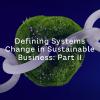The Sustainability Imperative
As organizations struggle to define a strategy that balances purpose and profit, opportunities are increasingly emerging to take the lead in sustainability initiatives. Front-line advances in areas such as net-zero emissions, AI-powered solutions for the underserved, precision agriculture, digital healthcare, and more are delivering business benefits, while simultaneously contributing to the realization of the UN’s 17 SDGs. We provide the expert thinking, debate, and guidance to help your organization reposition and transform in the era of sustainability.
Recently Published
P.J. Stephenson and Judith Walls call for a “new biodiversity paradigm for business.” They show that current corporate guidelines for engaging on biodiversity are inconsistent and confusing, leaving companies unable to manage nature-based risks, capture nature-based opportunities, and prevent disruptive climate change. To correct these inconsistencies, they identify fundamental issues that businesses and other actors must resolve in the links between market systems and the nature systems that generate biodiversity.
This issue explores how to make needed changes happen by examining three systems change topics. First, how can we use the linkages between environmental and economic systems to change market structure and, consequently, how actors compete? Second, how do we redefine waste to alter how market actors impact the natural environment through producing and disposing of materials? Third, what system changes can we accomplish through innovation or by using technologies like IT, artificial intelligence (AI), and blockchain to address unsustainable practices?
The right hemisphere of the metaphoric brain of firms will track and reflect changes in its employees’ brains, so firms must introduce new practices requiring mastery of the right hemisphere. As that shift occurs, the negative consequences of the firm’s actions should begin to abate.
Executive Update
Rethinking Sustainability: A Process Perspective
In this Executive Update, we explore taking a process perspective to show how concepts such as sustainability and the circular economy look in the physical world. Making these concepts concrete reveals a singular criterion for achieving a circular economy: every output generated by every process should have a consumer who uses it productively. This criterion provides managers with actionable steps and ways to measure their organization’s progress toward sustainability.
Material desires instigate purchases intended to bolster significance, which fosters increased materialism. Purchases increase GDP, which creates jobs and financial well-being and facilitates more purchases. Increased production to raise GDP uses carbon-based resources and further depletes them. This interdependence has locked society into what psychologists call a “social trap,” in which the pursuit of short-term individual gains leads to a loss for the group as a whole in the long run.
Helen Chen brings our focus on process and mechanisms to the domain of market-based social activism (MbSA), in which a business seeks to align its activities with moral principles to drive positive change at the society scale. Chen presents the Pyramid of Forces for Good framework that can be used to better organize MbSA to develop a “market for virtue” in which morally sound business activities outcompete those that are morally questionable. A market for virtue applied to green performance is based on three building blocks: (1) valid and reliable green-performance measurement, (2) fair and equitable green-performance valuation, and (3) efficient and scalable green-value apportionment. Establishing a market for virtue would make green practices economically profitable, fundamentally changing the economic system that currently makes unsustainable practices more economically profitable than green practices.
Rachana Shah explores system stability and points of intervention in a specific, highly complex system: the New York City Waste system. Shah uses systems theory to analyze specific actors and their actions to reveal key leverage points for change within the system. She prioritizes the leverage points by their potential for impact on the system, elucidating exactly what each leverage point can change, who will be affected by the change, and what effect the change could have on the system. She then explores the negative feedback processes that resist systems change, pointing out that the higher in impact a leverage point is, the more a system will resist it. Shah’s analysis demonstrates how actors can decompose a system into subsystems, identify key change points, and prioritize each change point by balancing its potential for impact against its potential to generate negative feedback from the system that cancels out the impact of the leverage point. Her focus on actors and their actions raises a valuable point for systems analysis. The way you analyze a system influences what you believe to be the key leverage points in the system and influences the effectiveness of systems change strategies built from that analysis. Conceptualizing the waste system as actors and actions highlights leverage points related to actors themselves. However, this way of viewing the system may obscure system processes and leverage points not related to actors, such as technological leverage points around material production and distribution or biophysical leverage points around waste decomposition.
The authors argue that systems are designed to produce their results, even when their results are far from perfect. Systems also have internal “negative feedback processes” that maintain system stability by canceling out disruptions. Overcoming these stabilizing systems can be challenging, and pushing a system far enough to initiate change can result in sudden, highly disruptive shifts to a new system. Rather than cause such disruptive change, the authors advocate for incremental shifts to avoid the kind of wholesale disruption that could leave financial, social, and political systems in shambles.




















